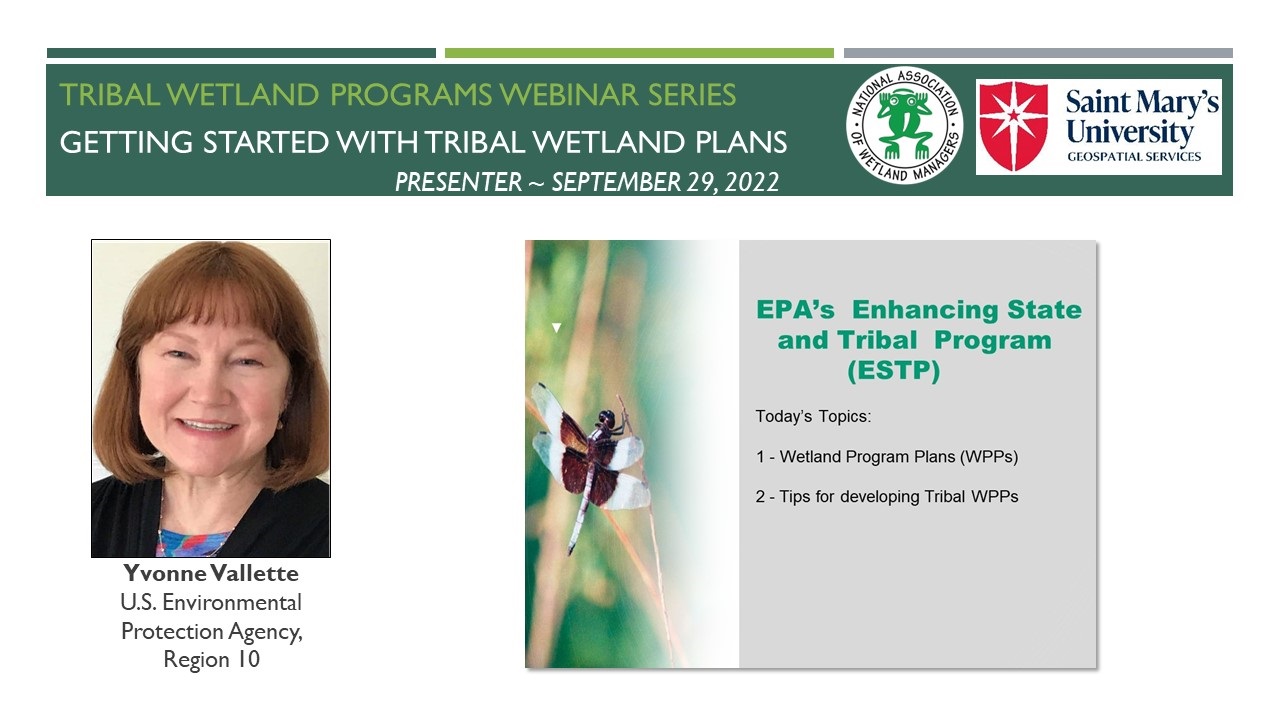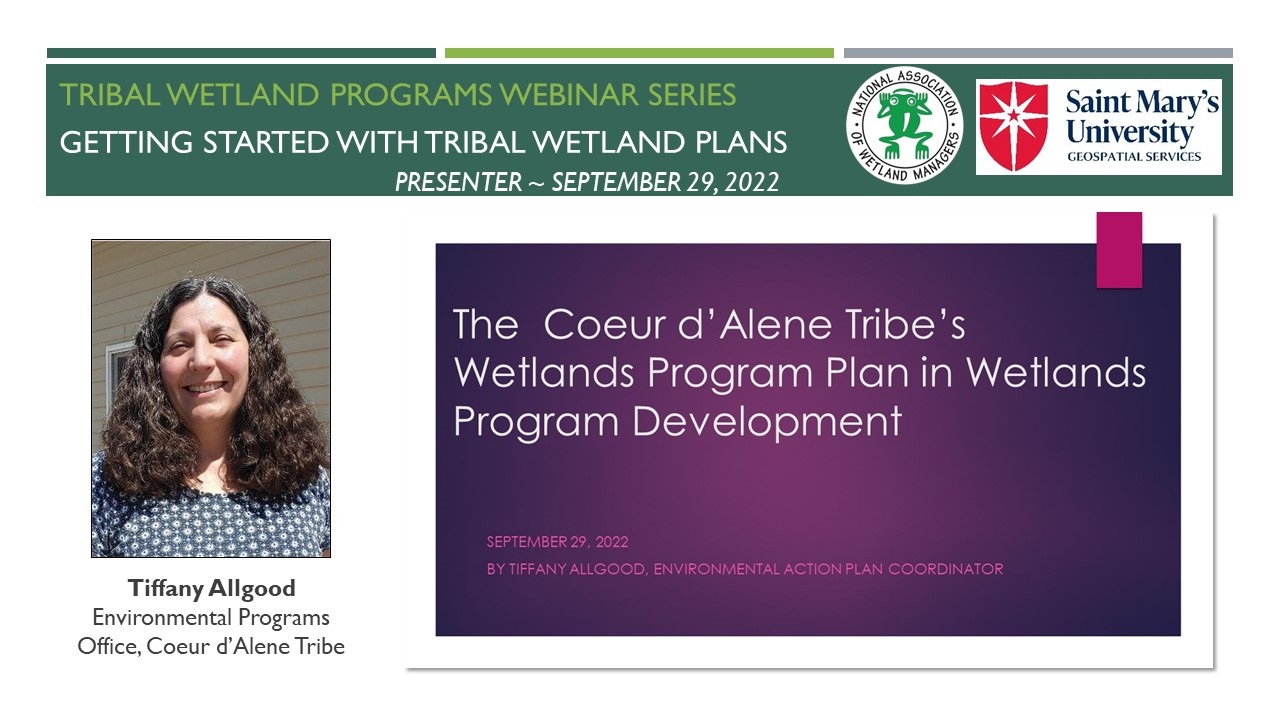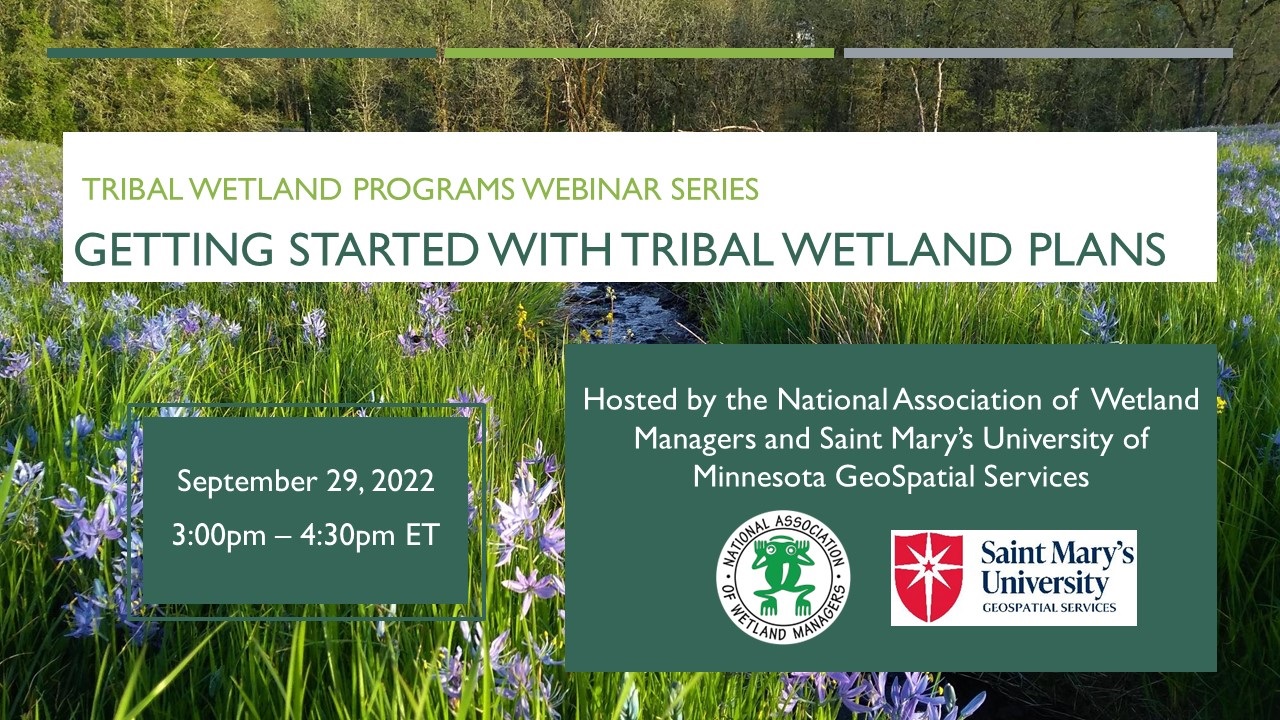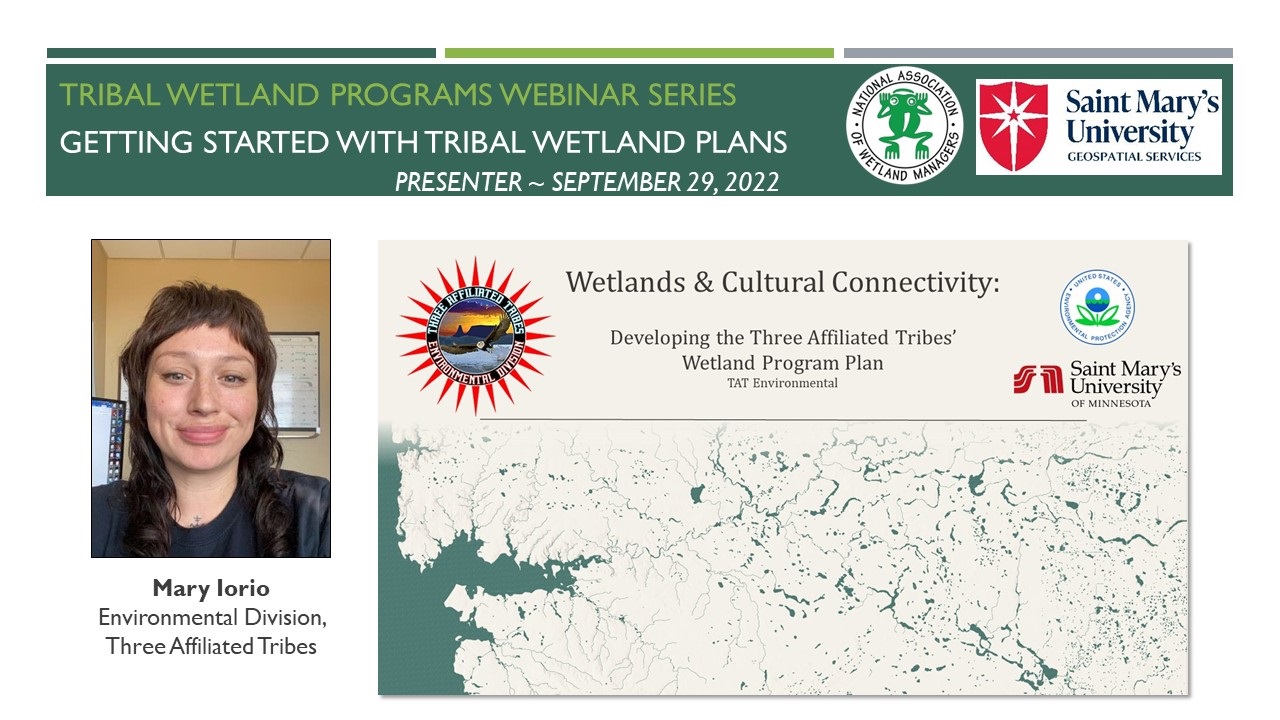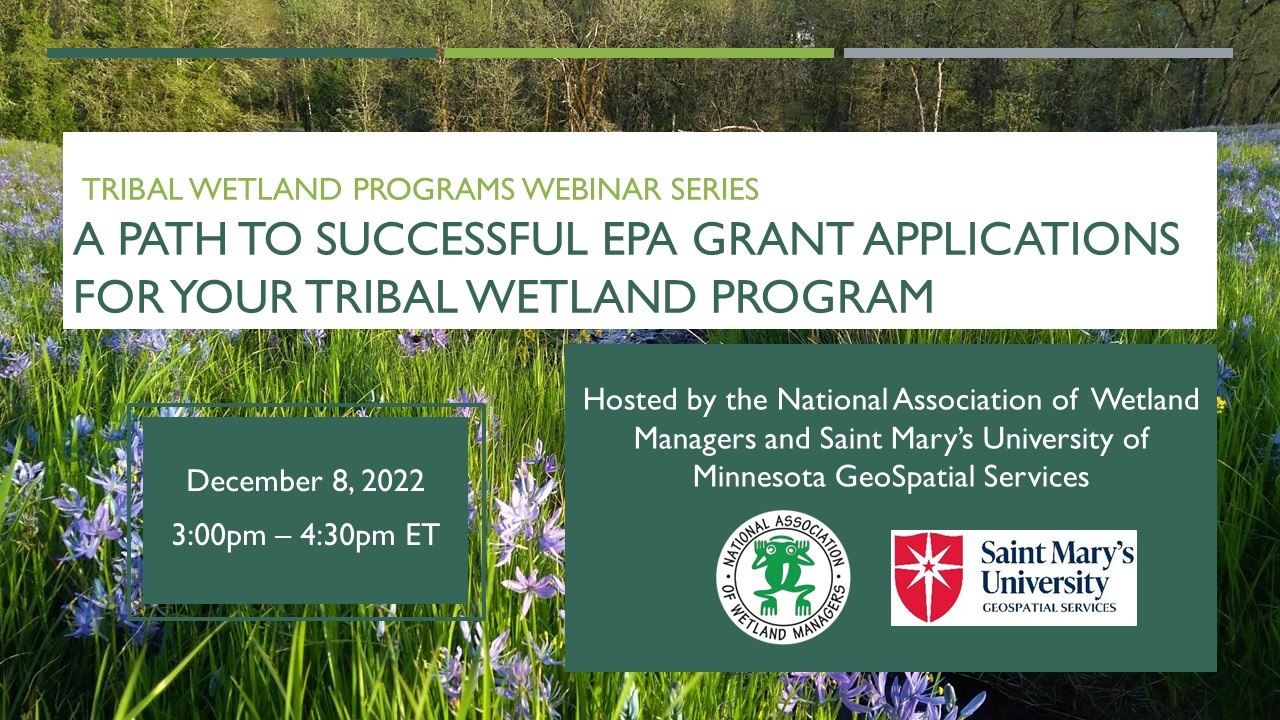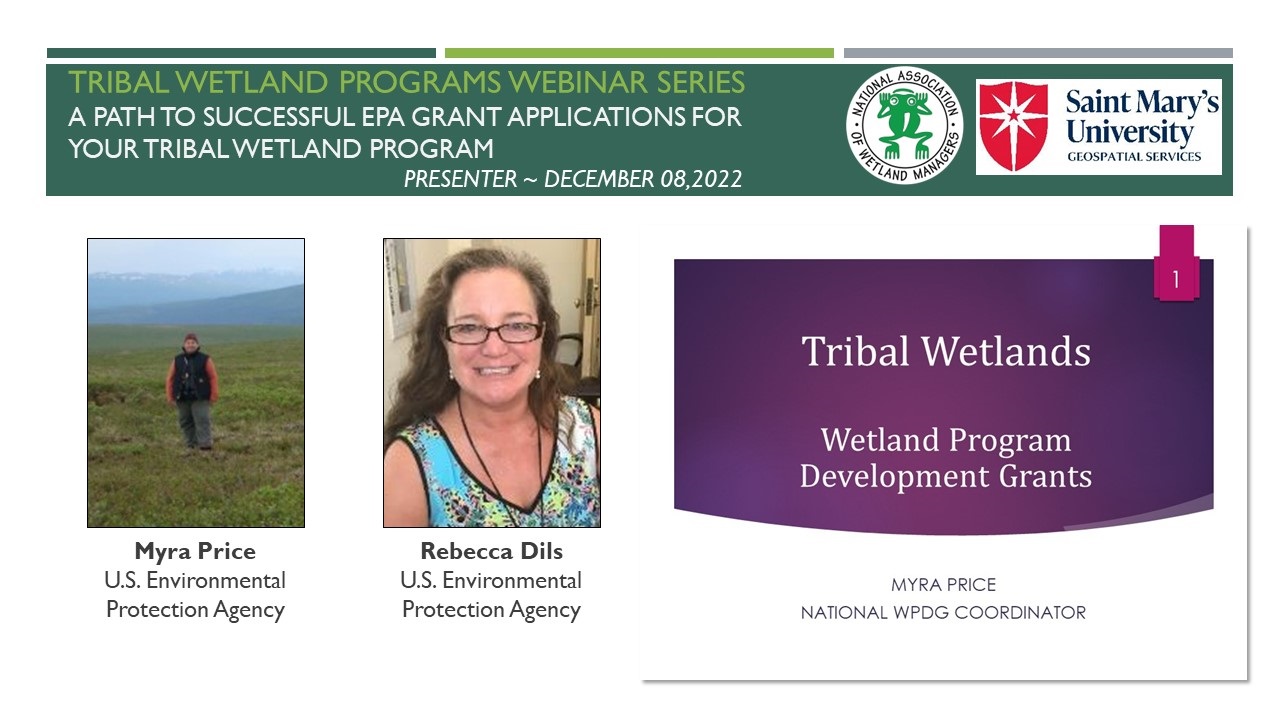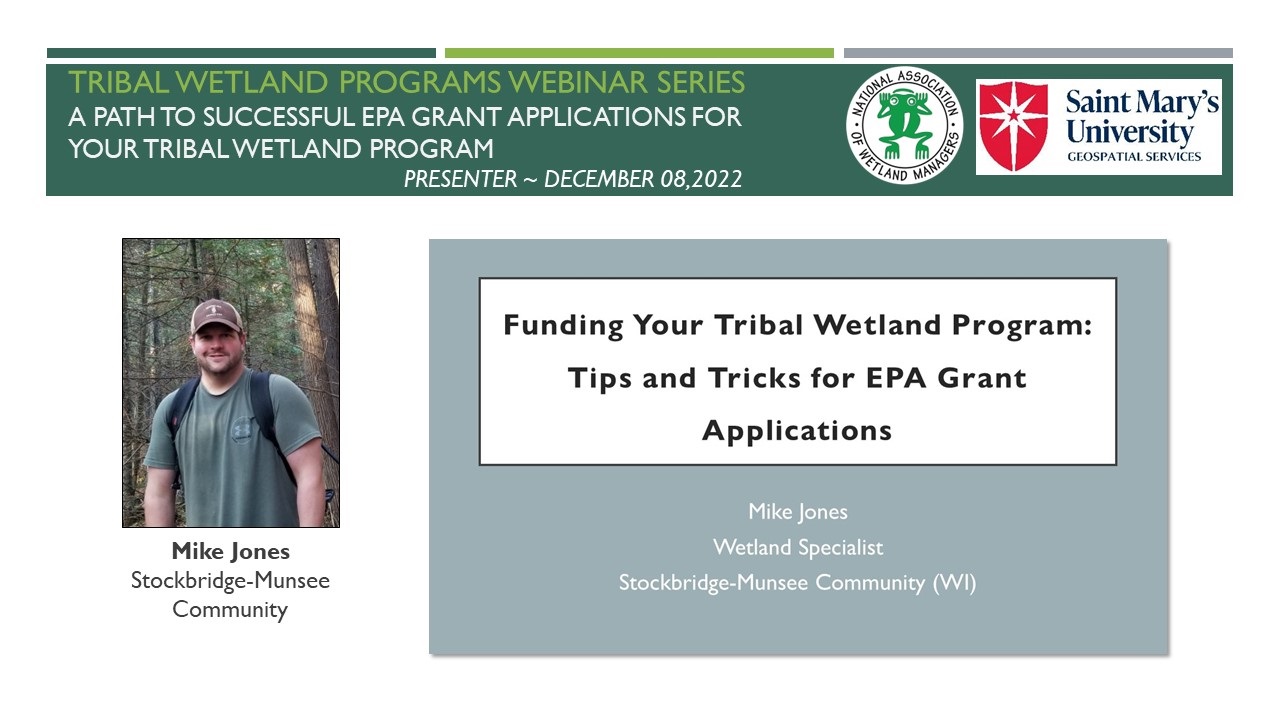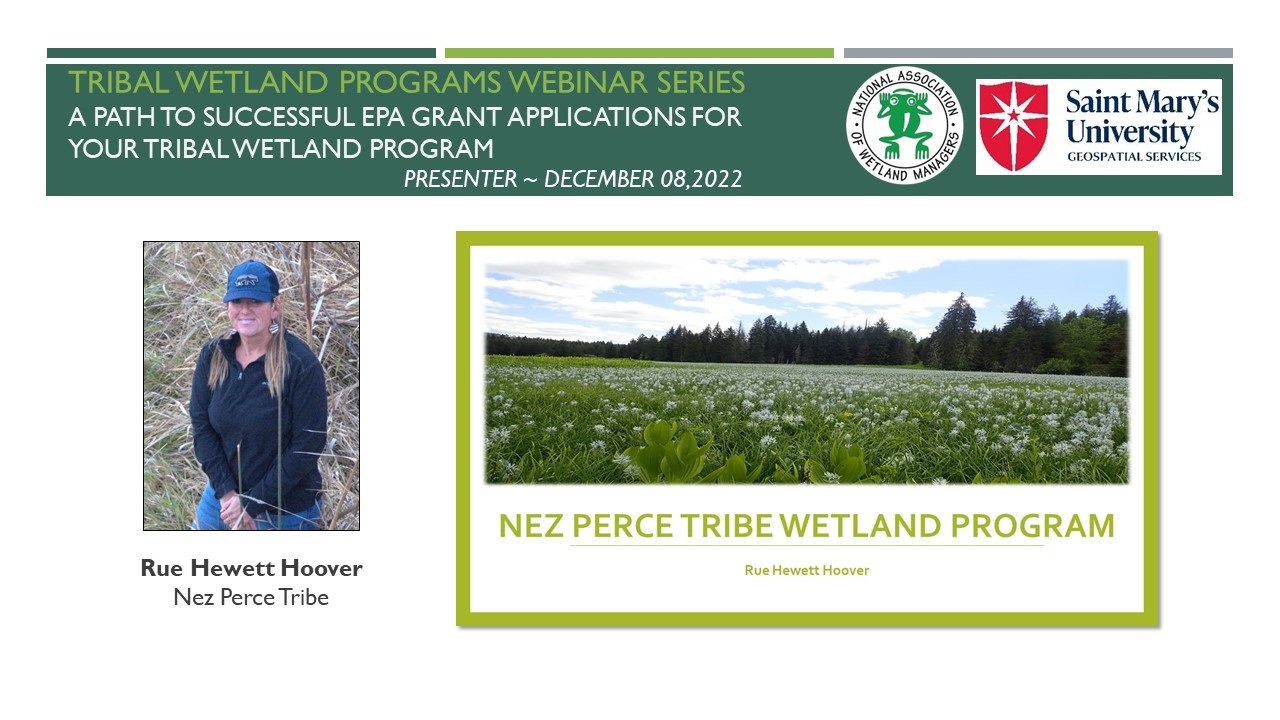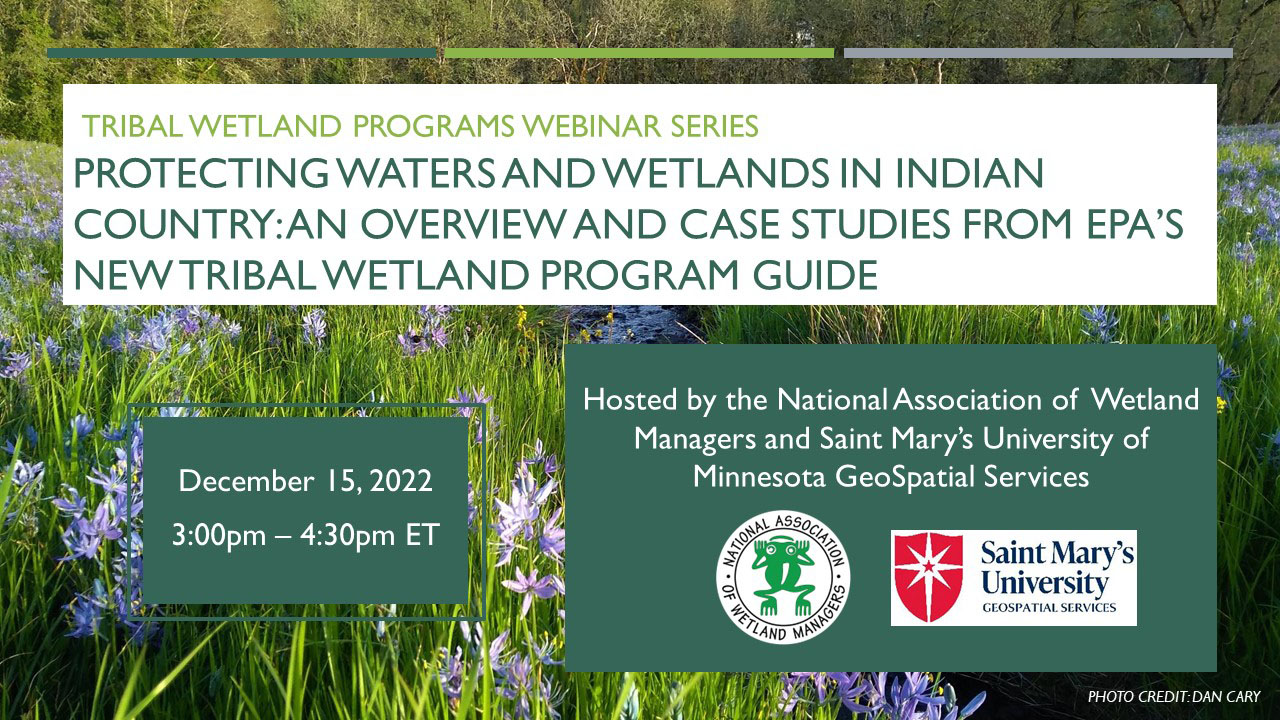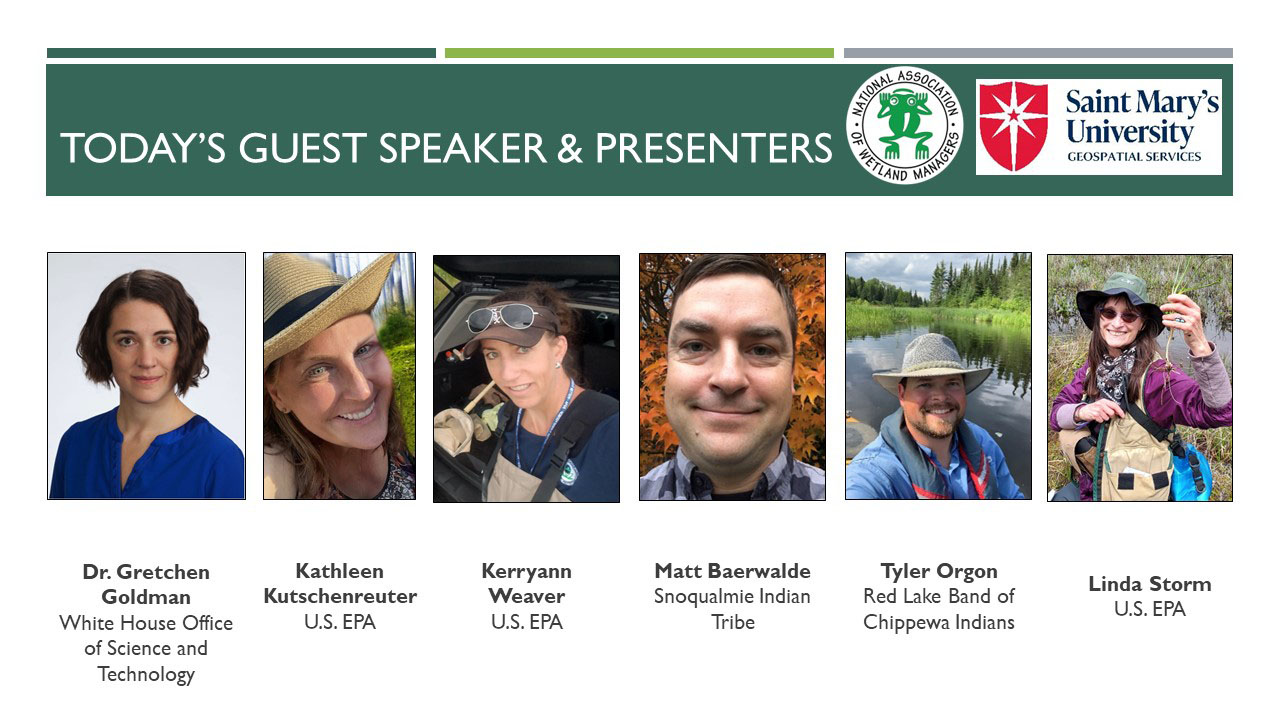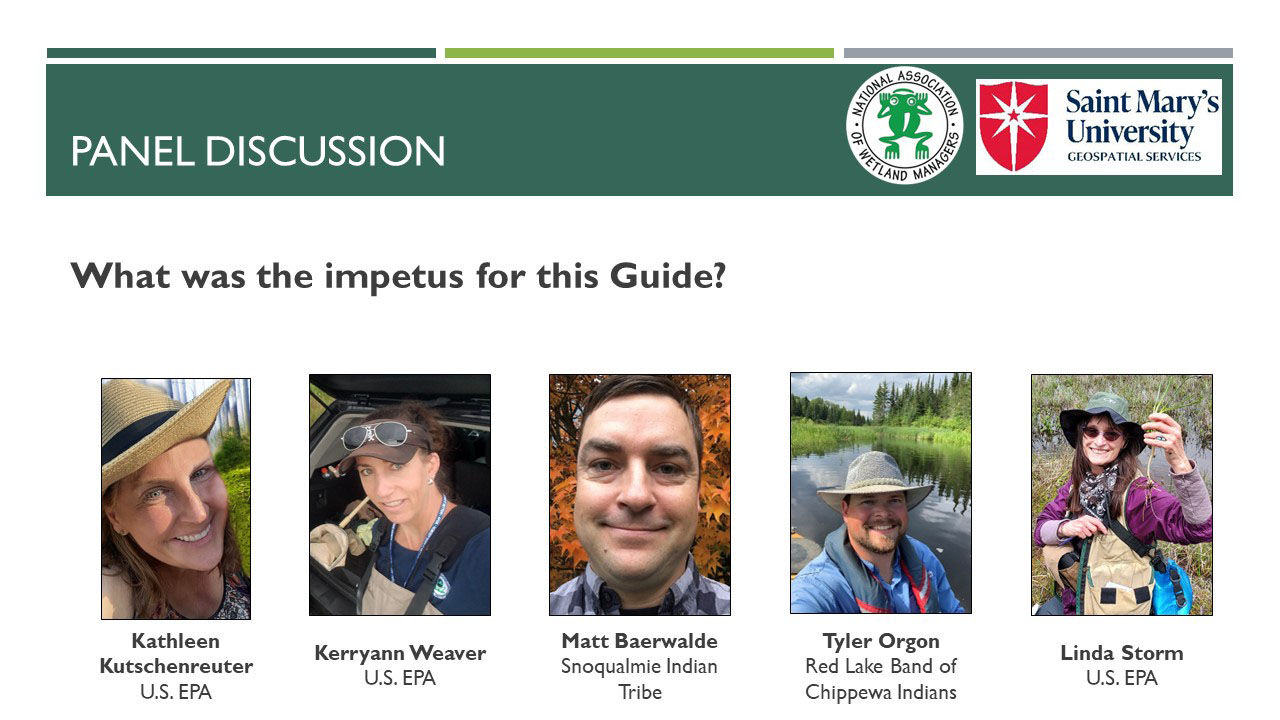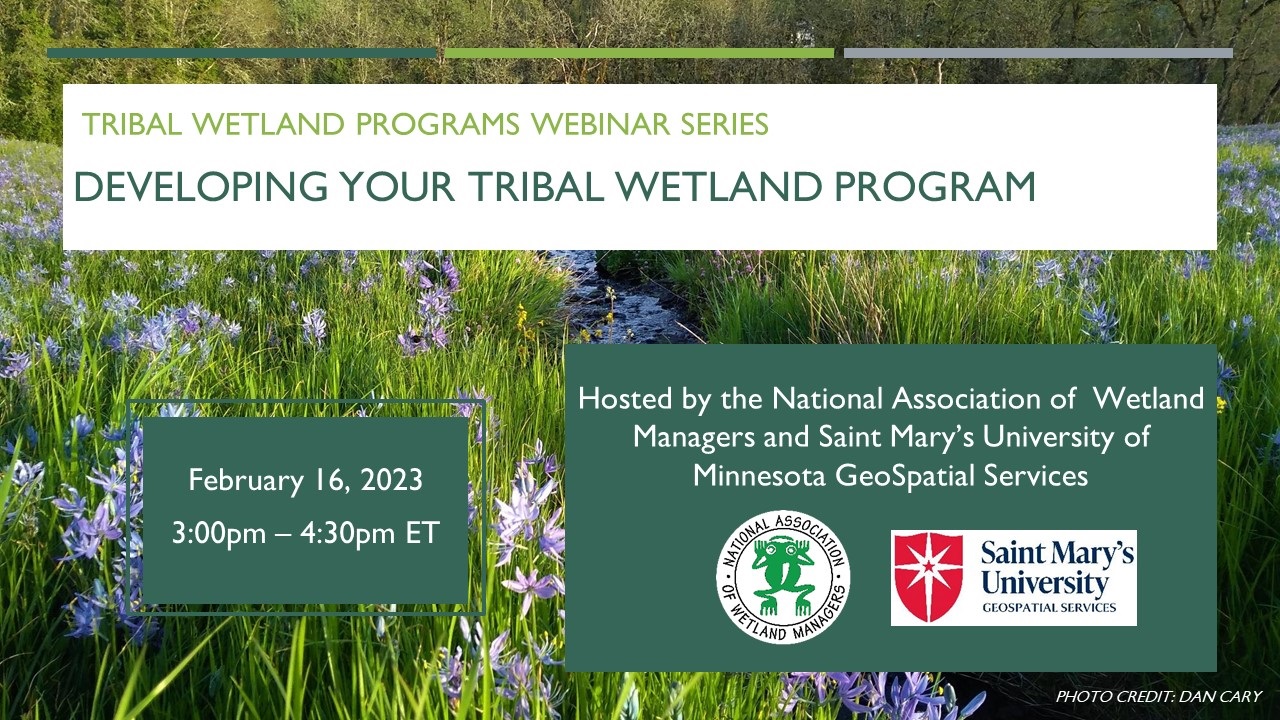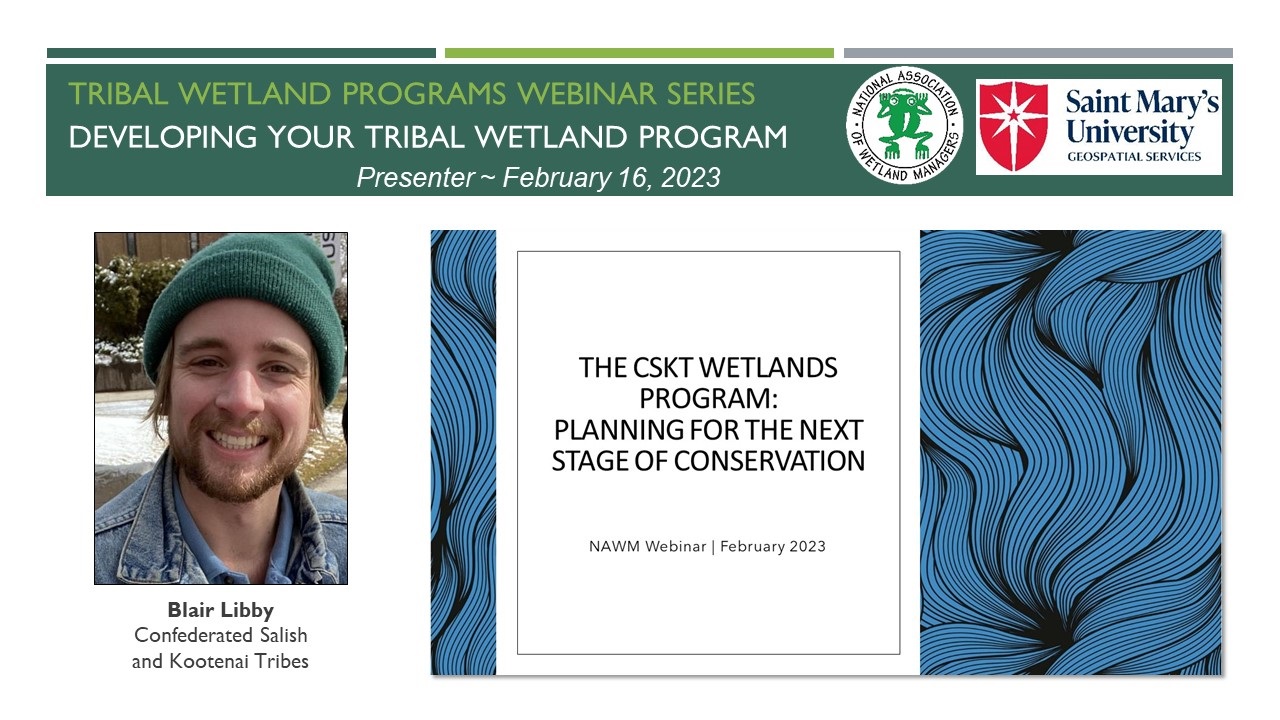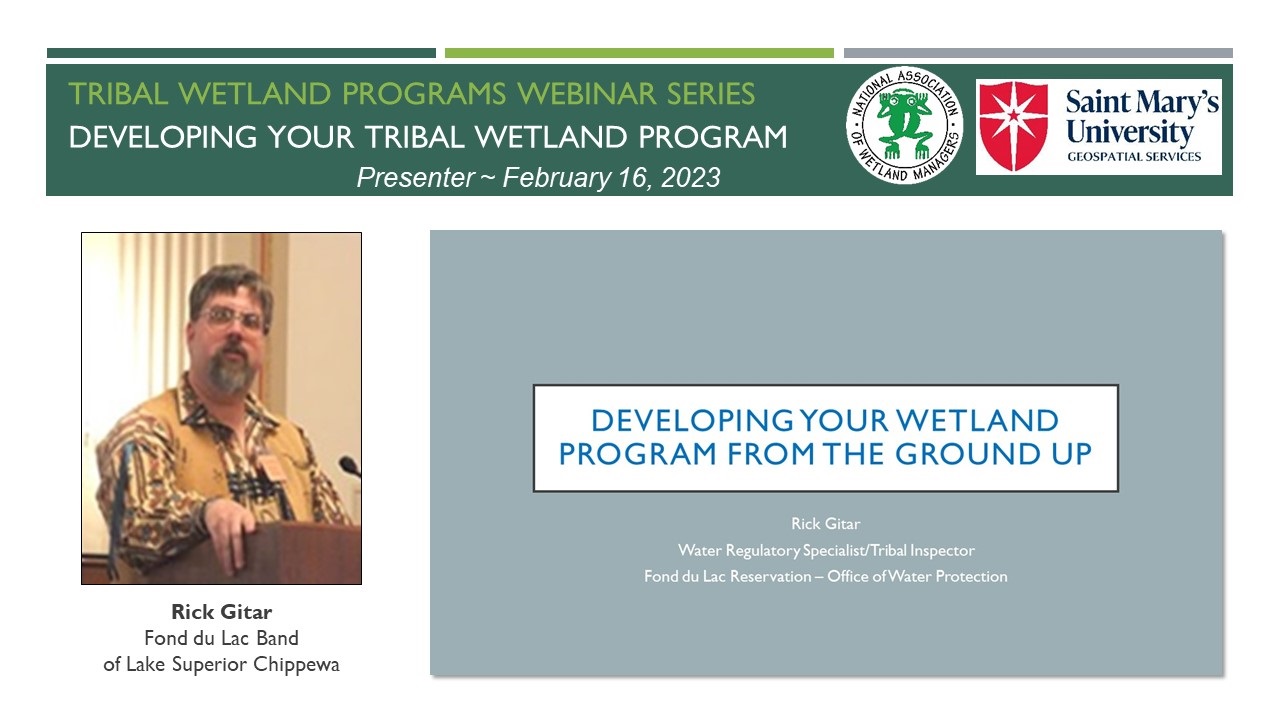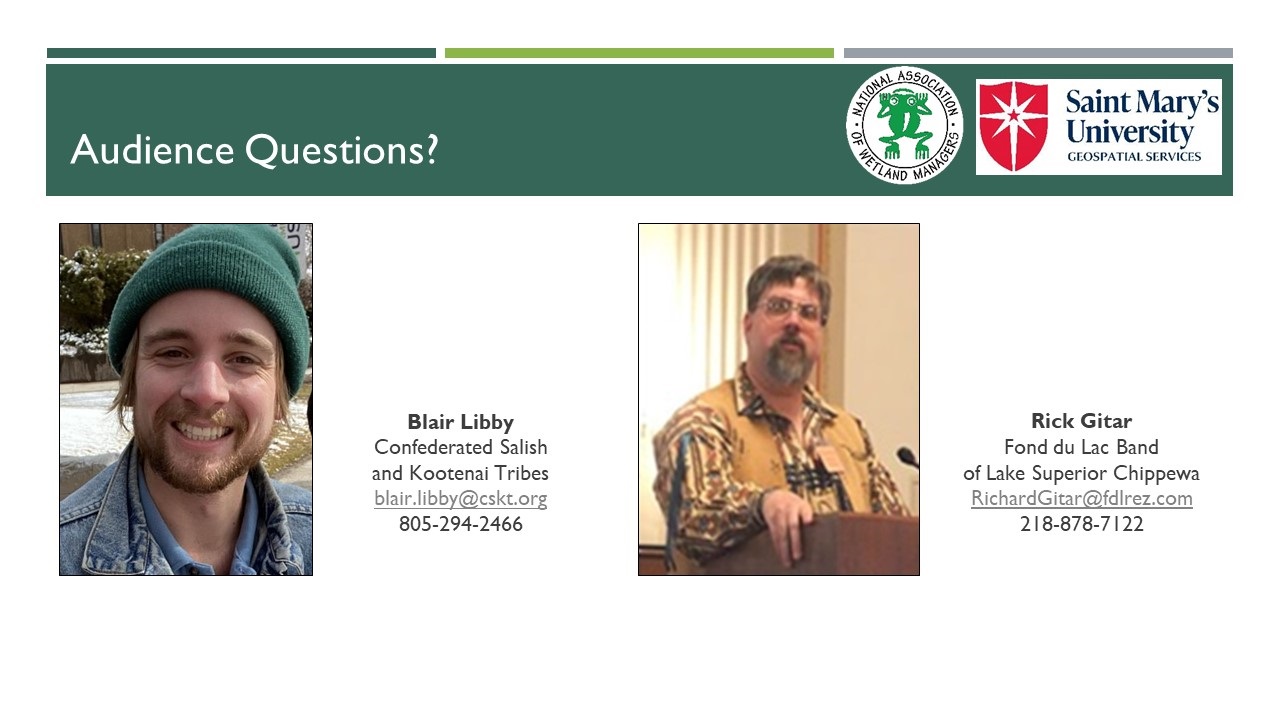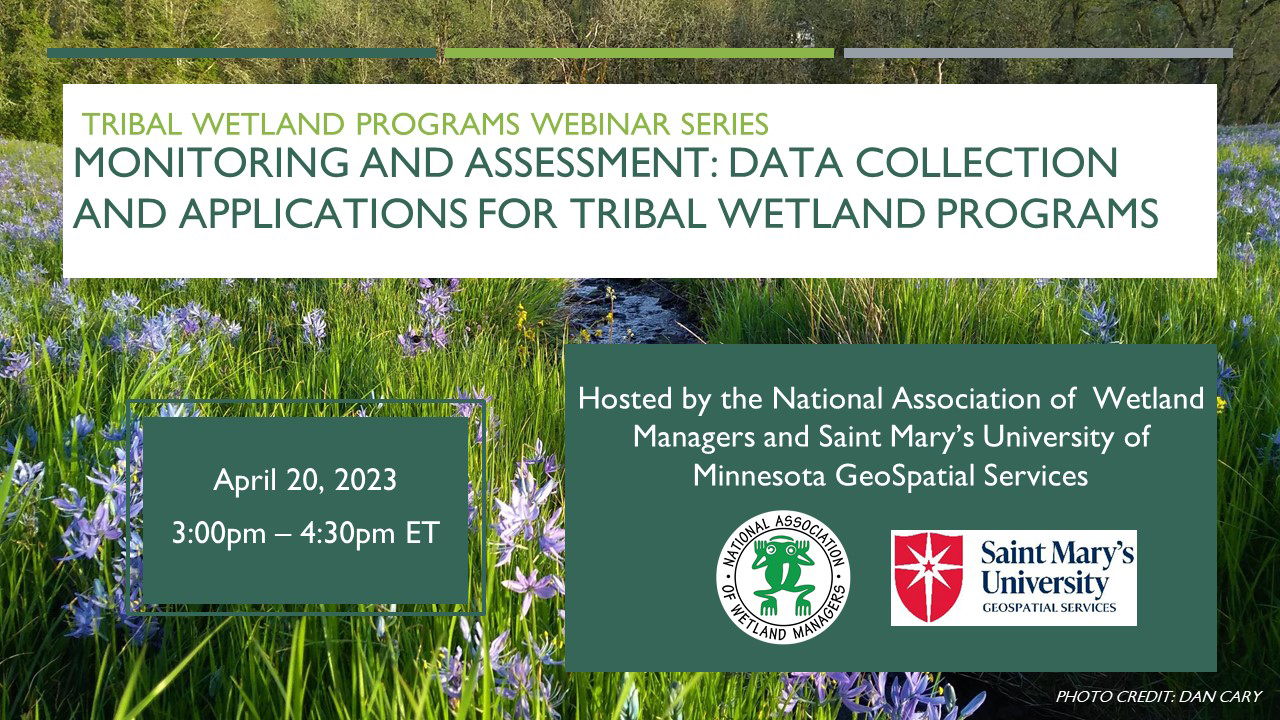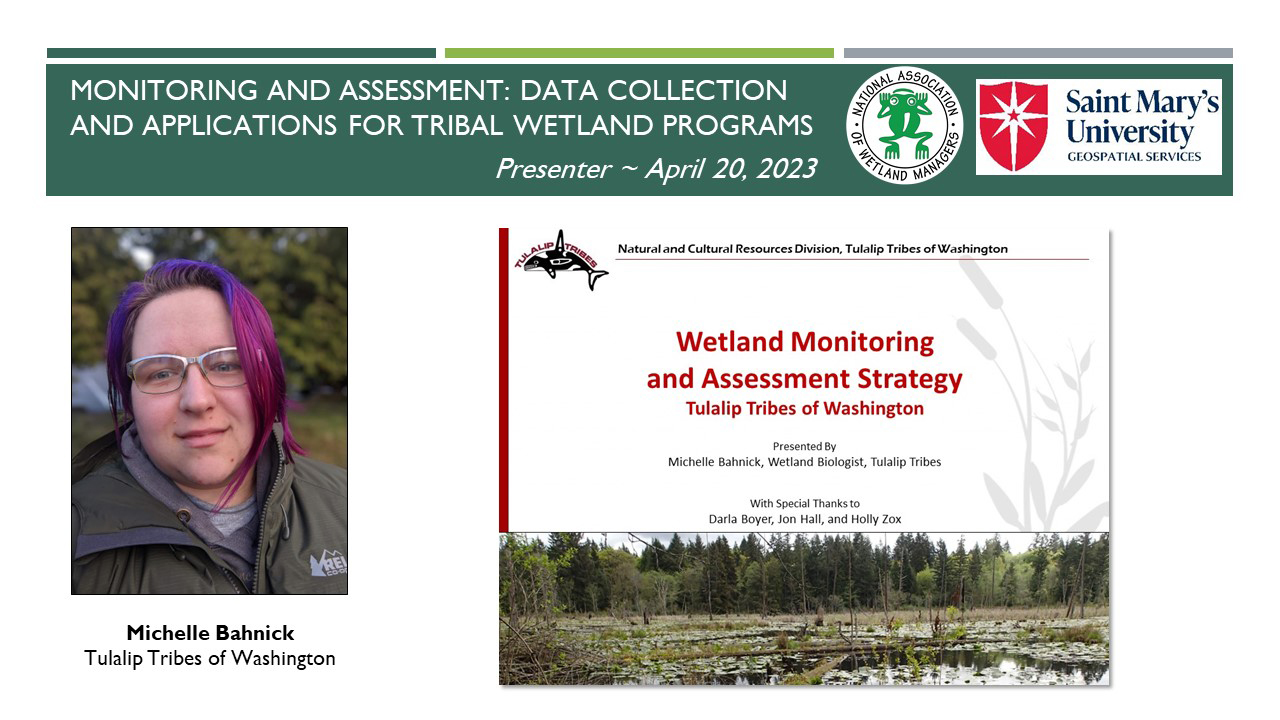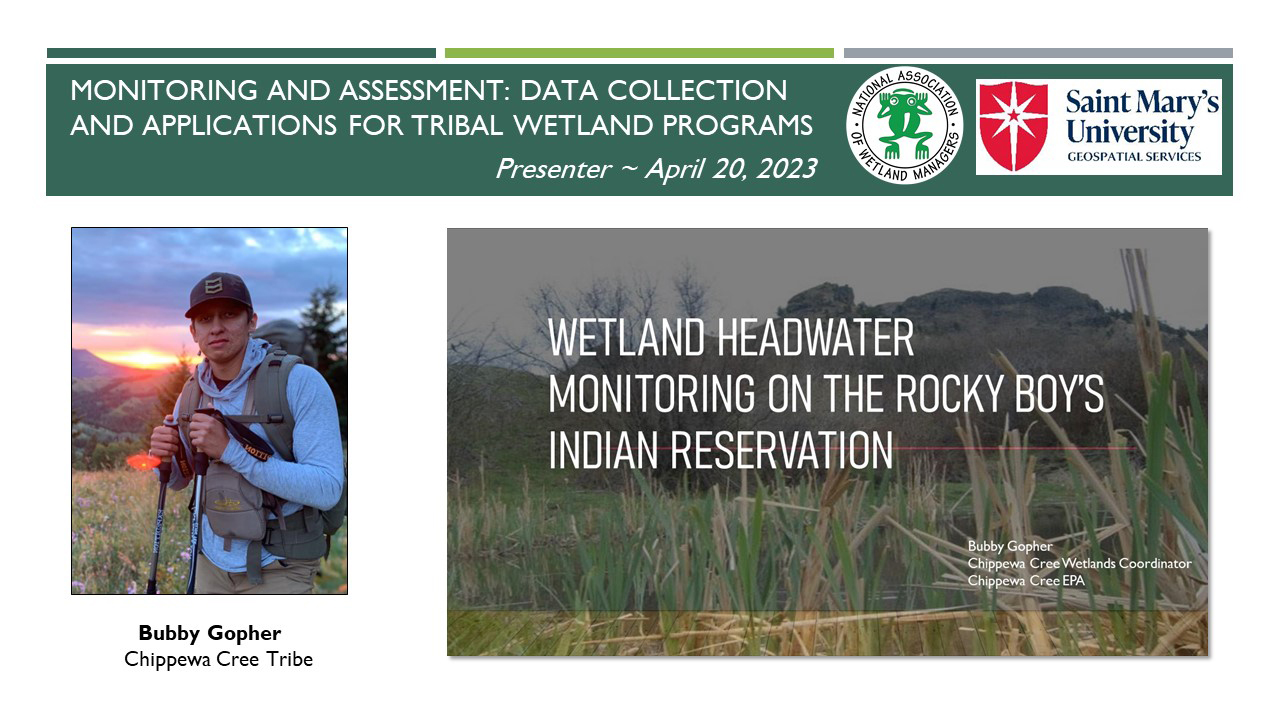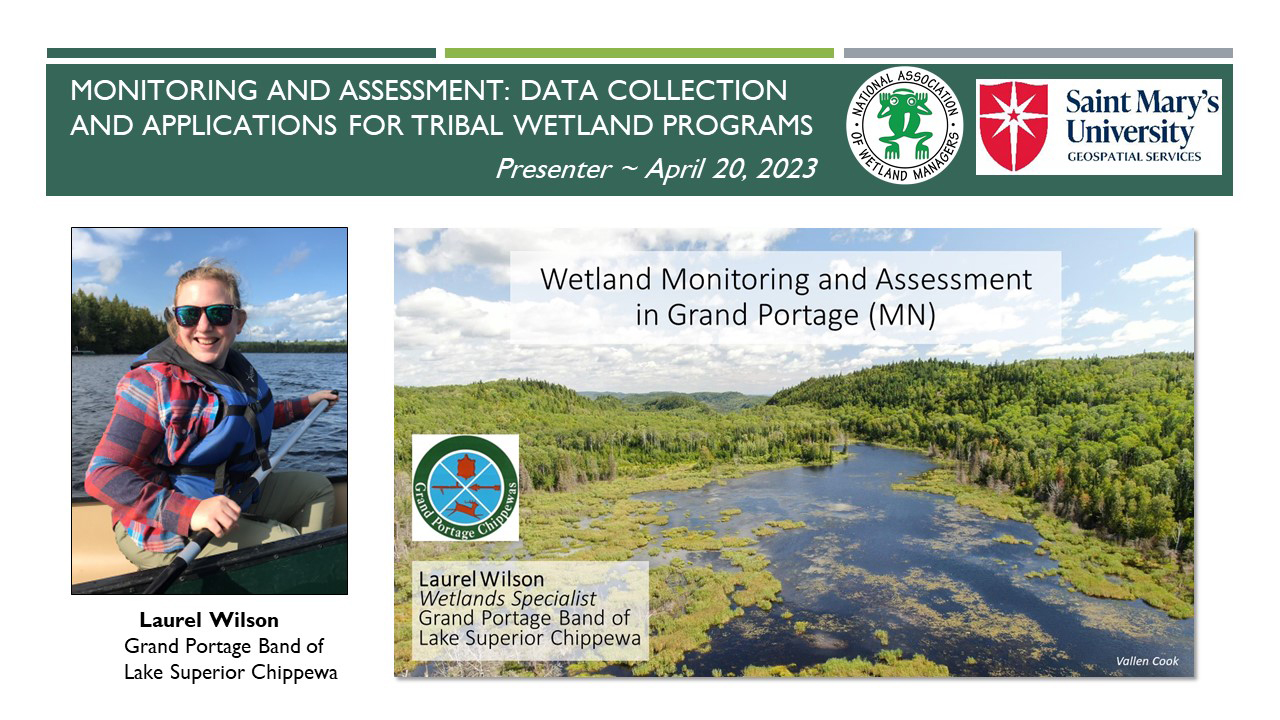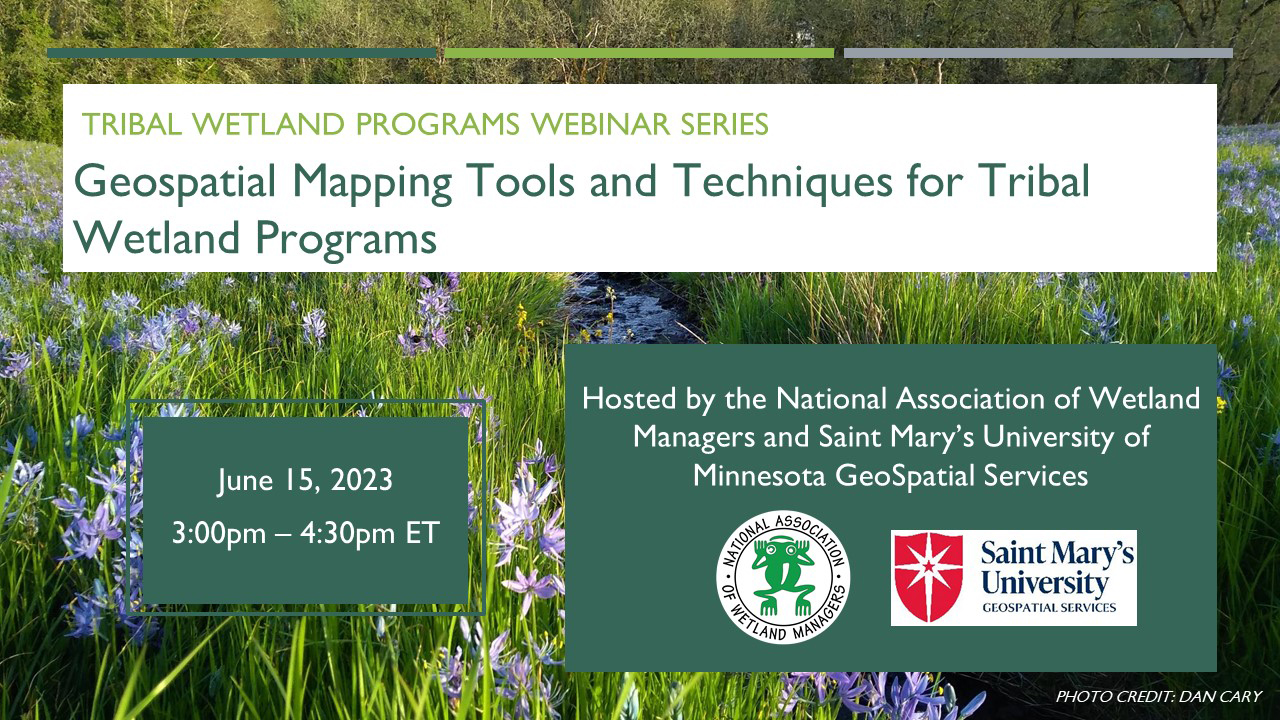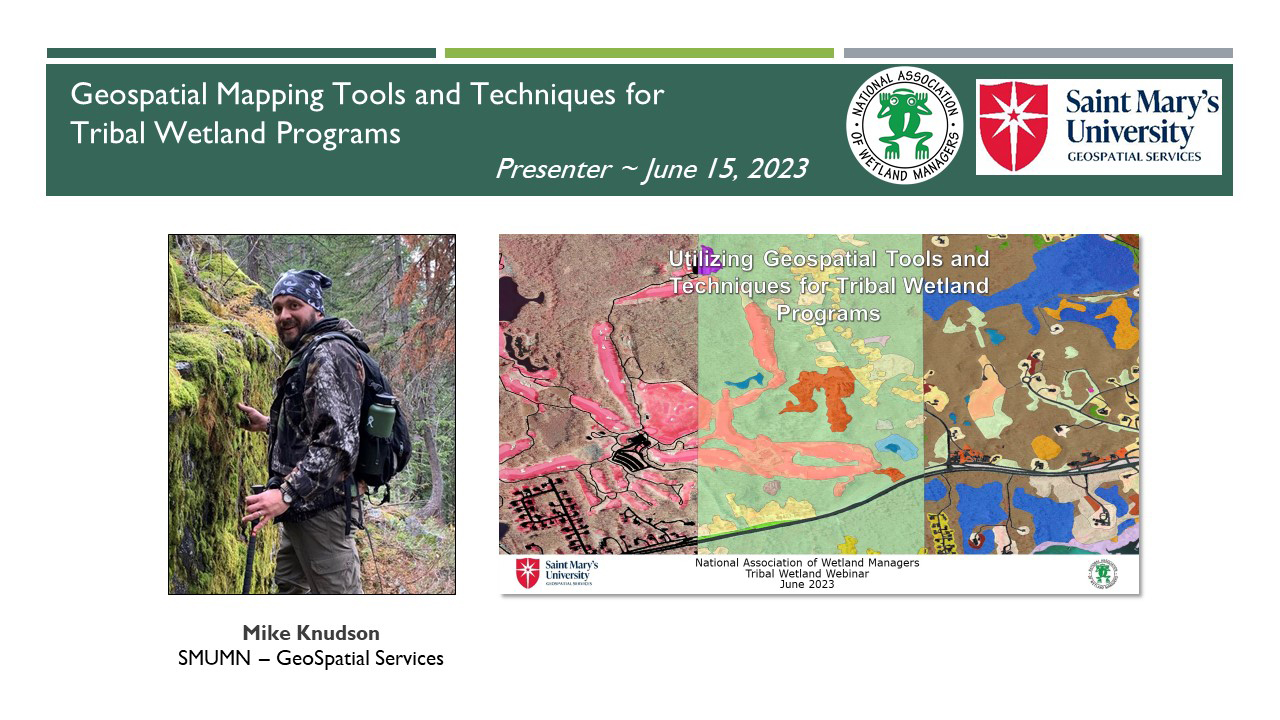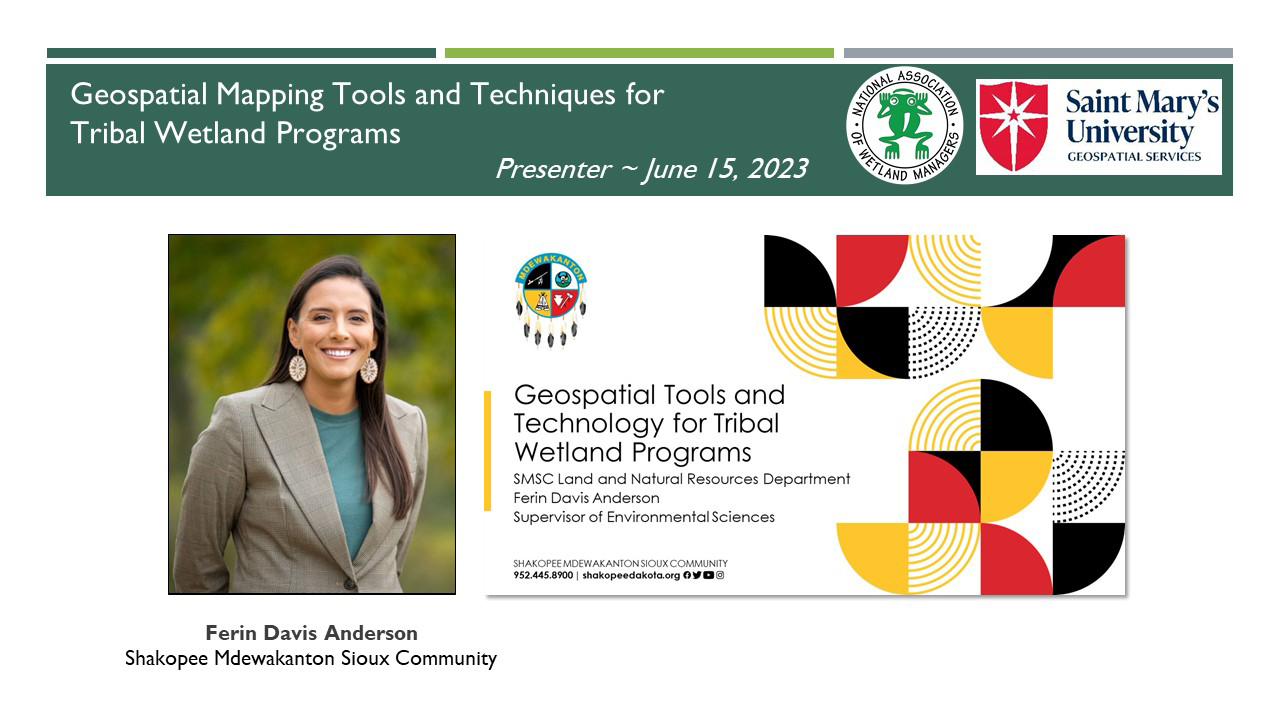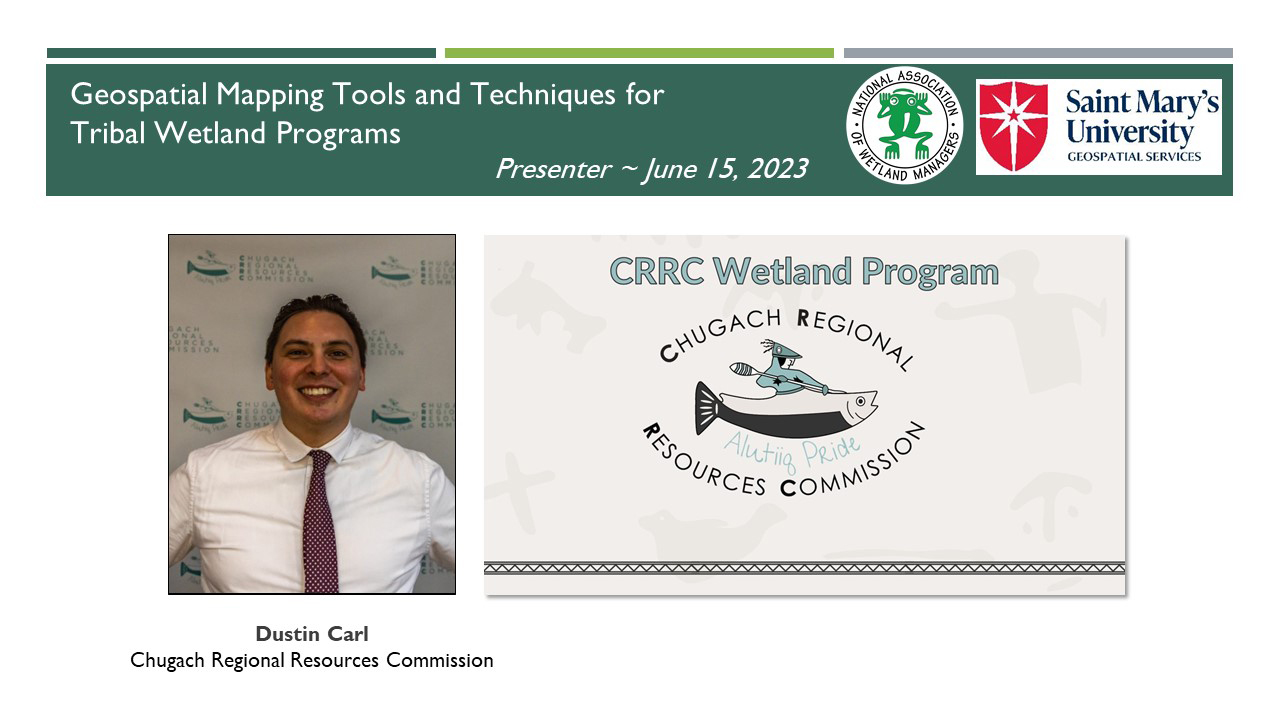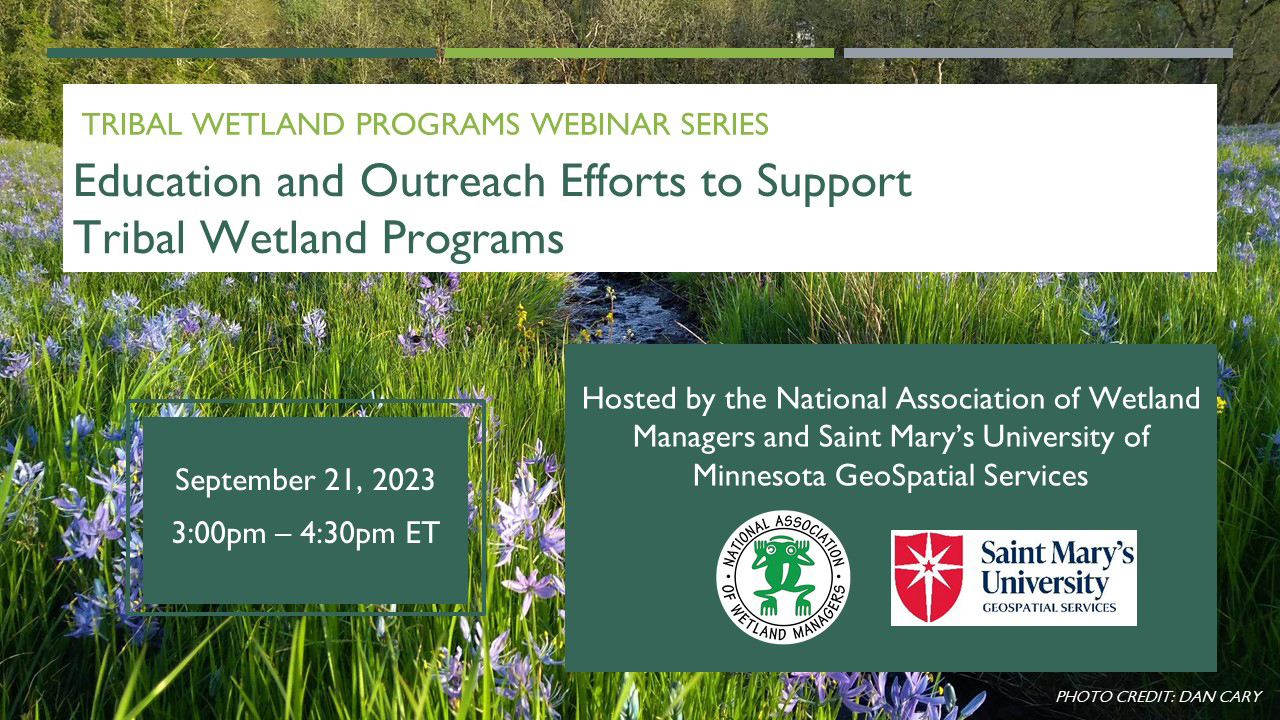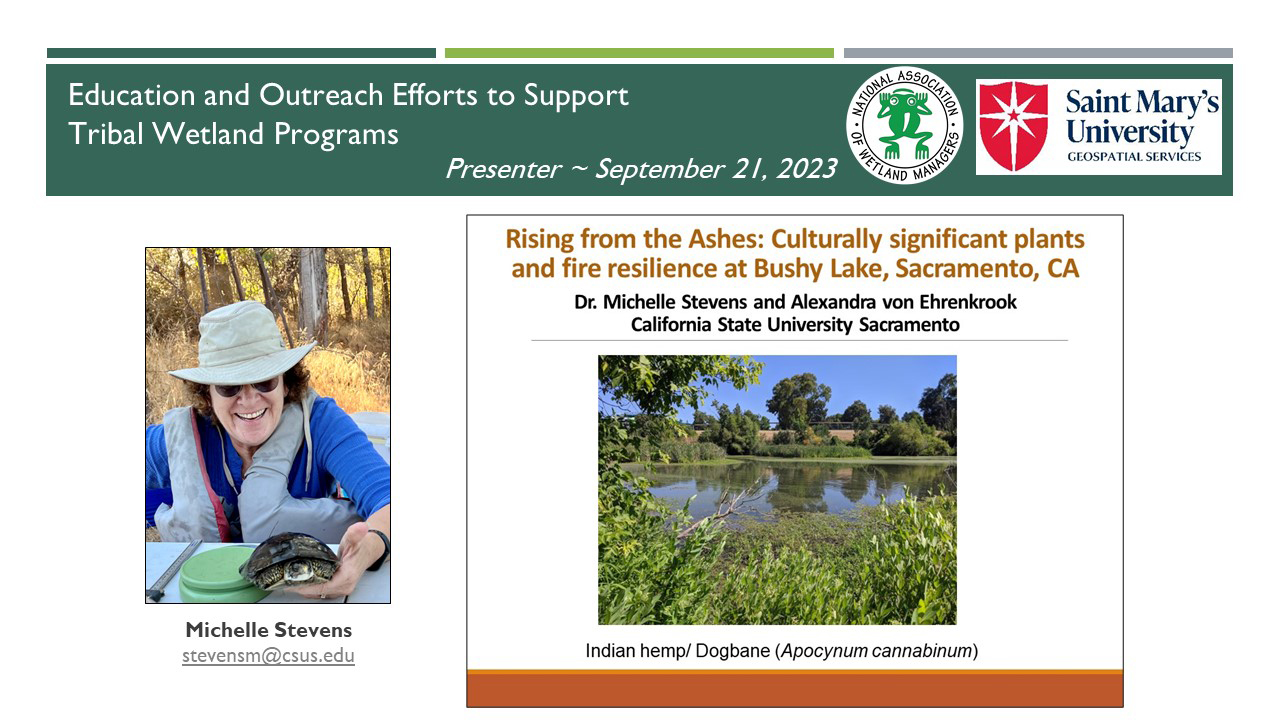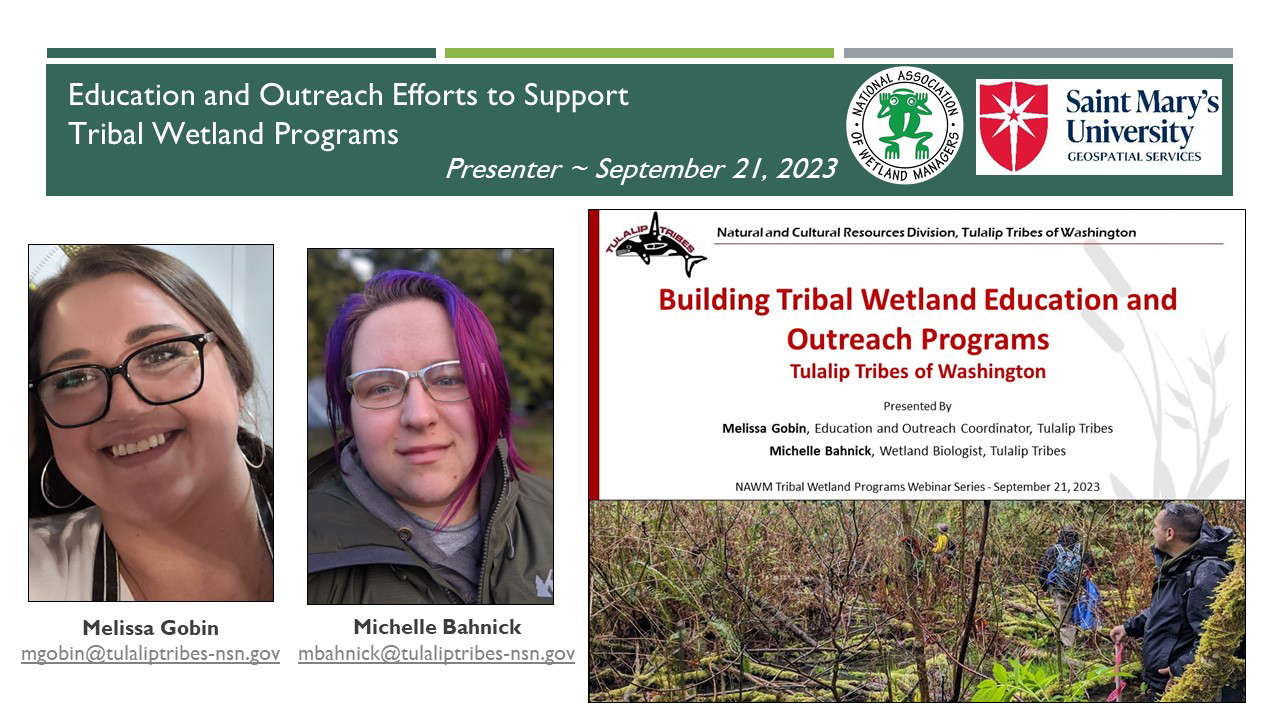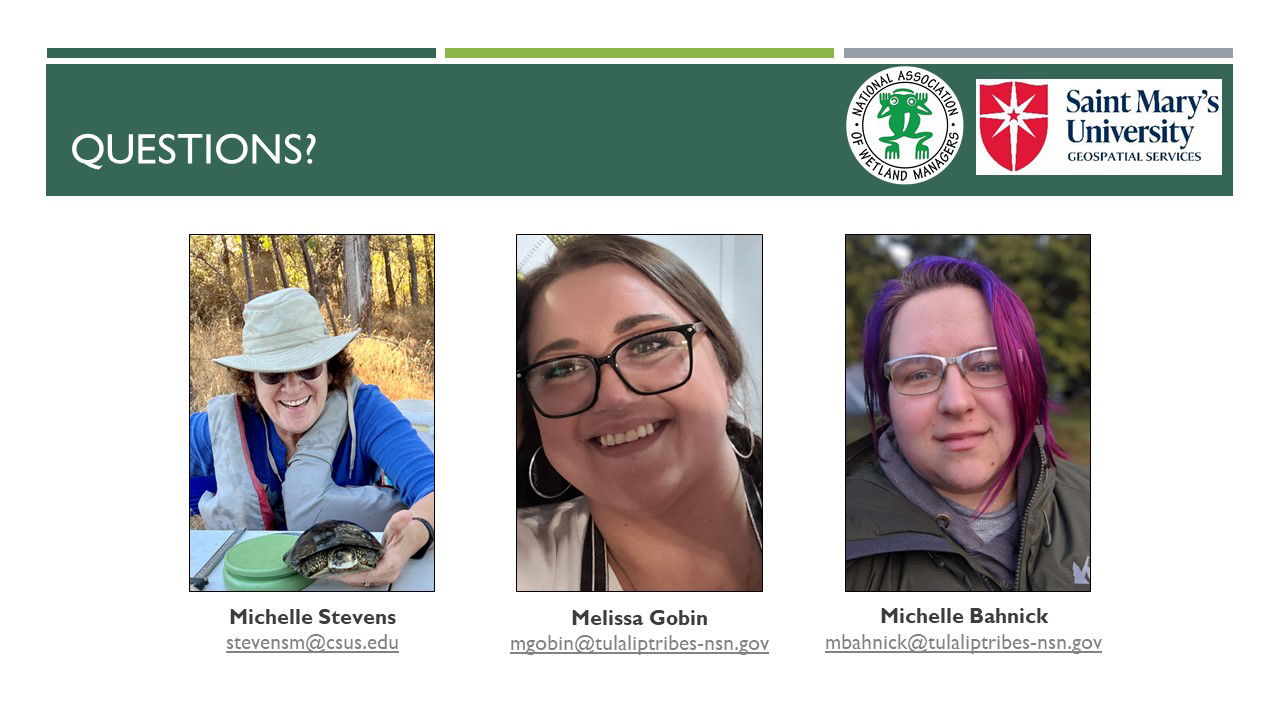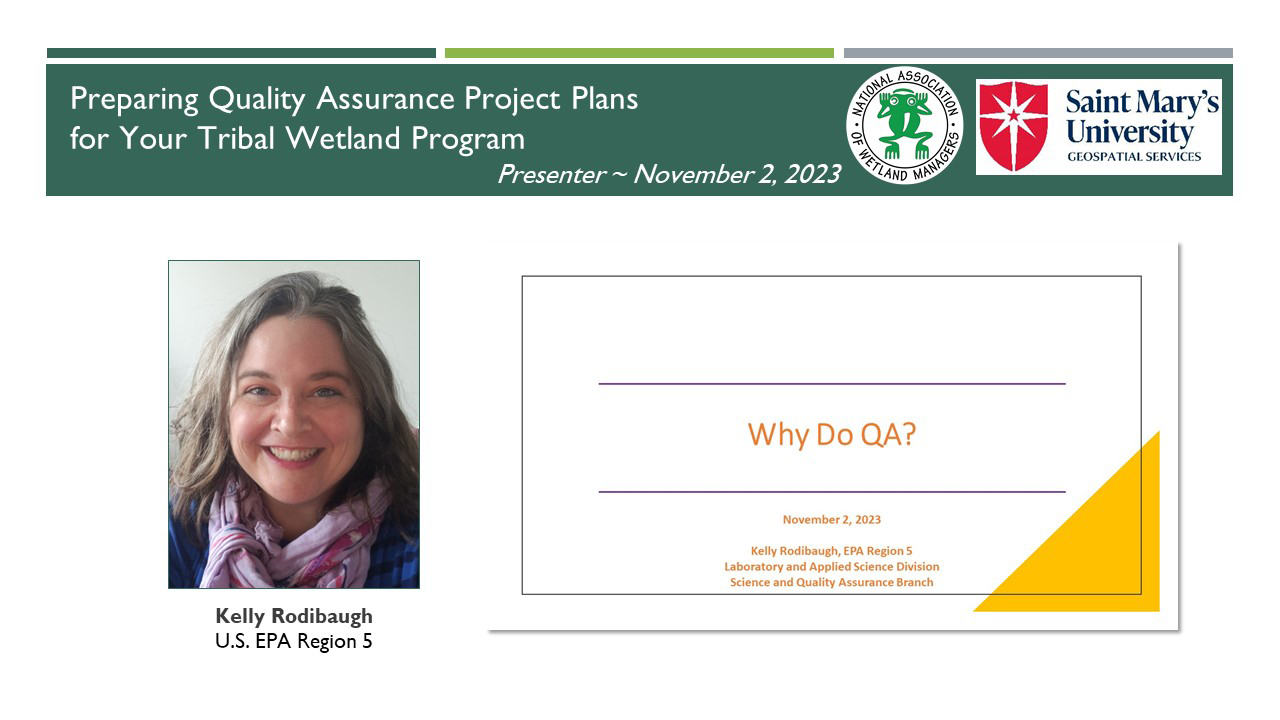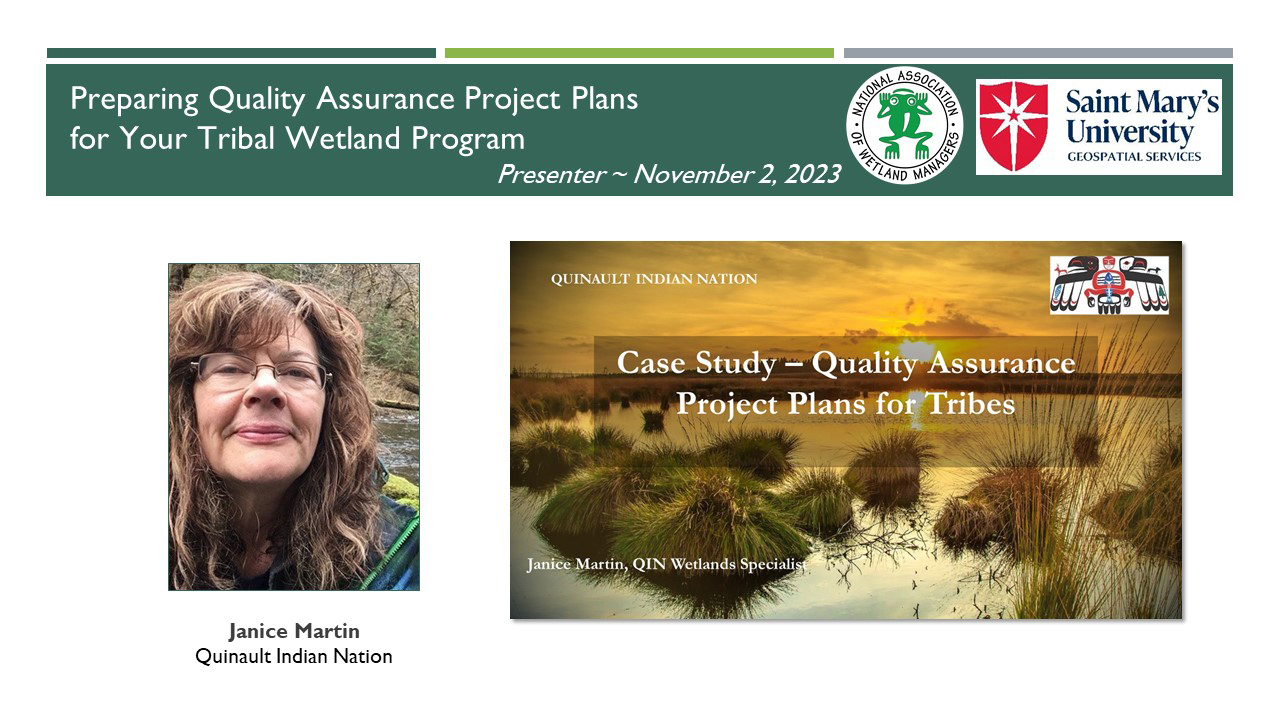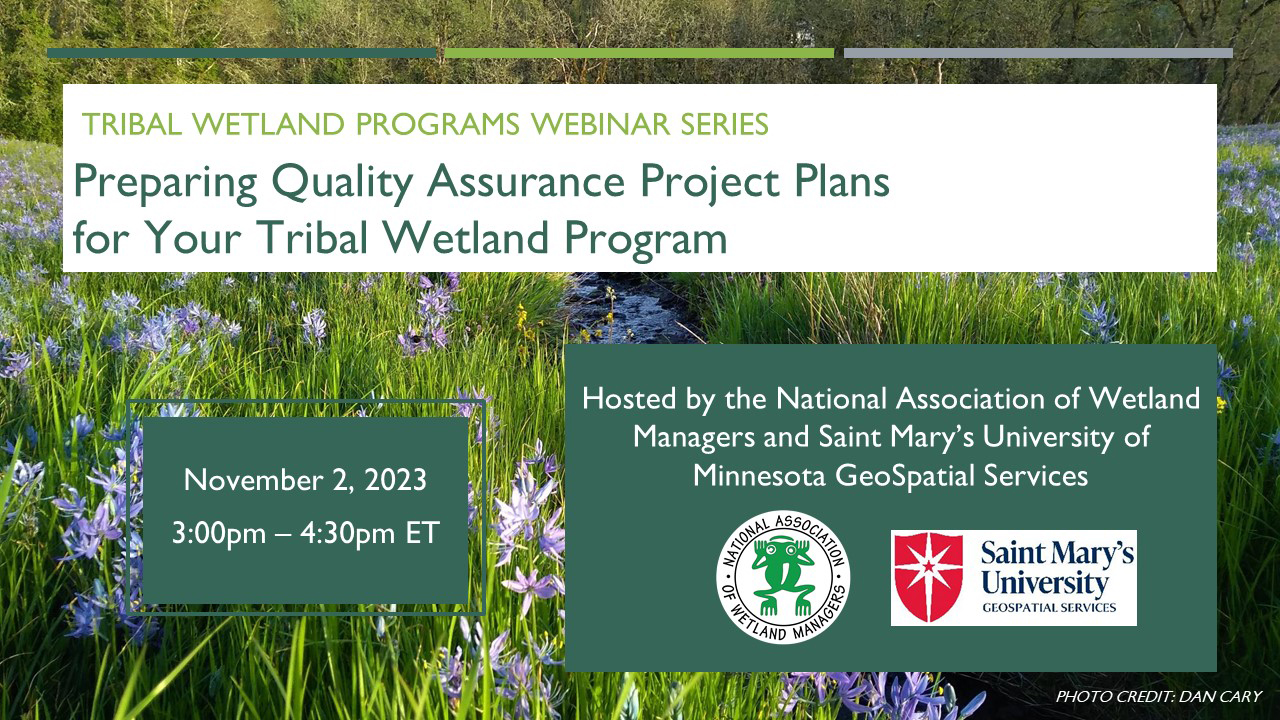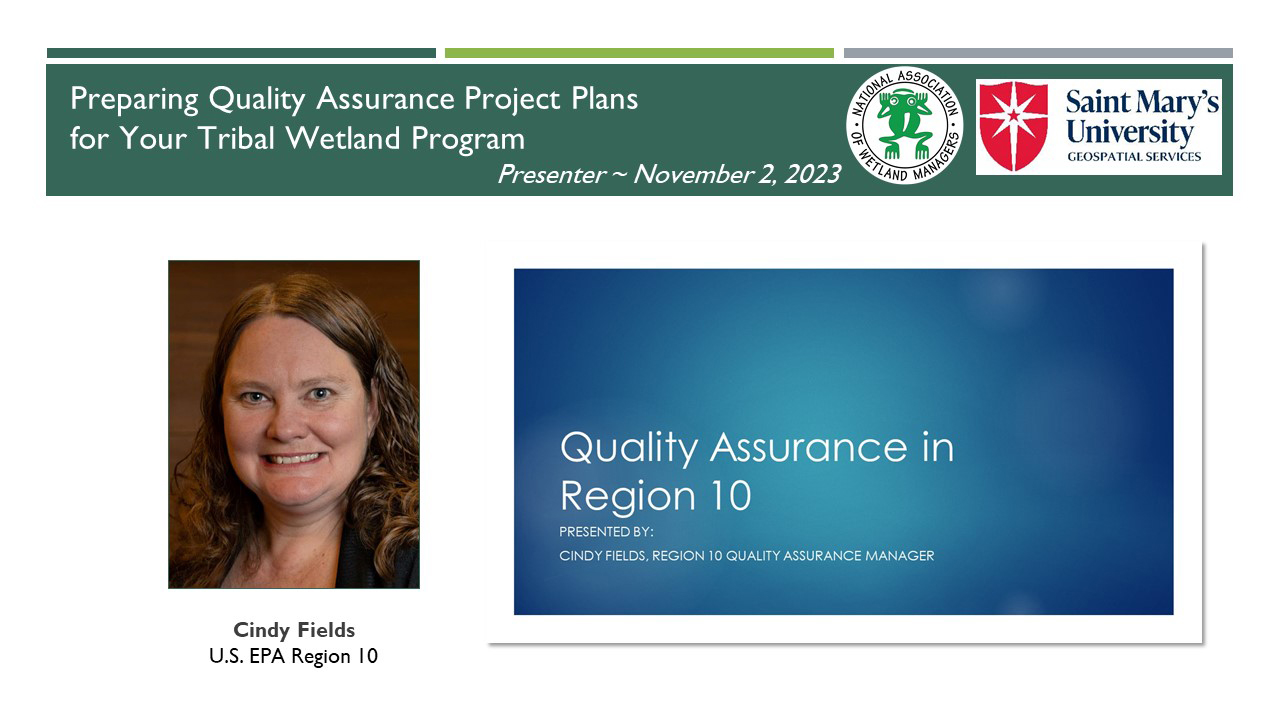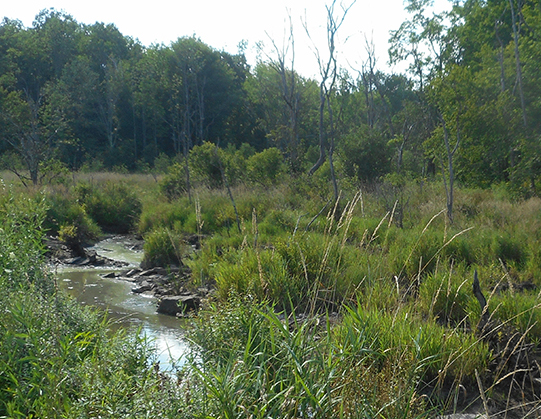 The National Association of Wetland Managers (NAWM) and Saint Mary’s University of Minnesota GeoSpatial Services (SMUM) developed a series of webinars focused on increasing the capacity of Tribal Communities to protect, restore, and mitigate impacts to tribal wetlands. The webinar series was developed with guidance from an advisory workgroup composed primarily of Tribal wetland managers. The webinars, which were held in 2022 and 2023, cover the basics of starting and building a tribal wetland program and feature presentations from EPA staff and tribal representatives from across the country.
The National Association of Wetland Managers (NAWM) and Saint Mary’s University of Minnesota GeoSpatial Services (SMUM) developed a series of webinars focused on increasing the capacity of Tribal Communities to protect, restore, and mitigate impacts to tribal wetlands. The webinar series was developed with guidance from an advisory workgroup composed primarily of Tribal wetland managers. The webinars, which were held in 2022 and 2023, cover the basics of starting and building a tribal wetland program and feature presentations from EPA staff and tribal representatives from across the country.
The target audience for this online training series is tribal wetland and aquatic resources staff, including field staff and managers who are interested in forming or developing a wetland program, as well as other wetland and aquatic resource professionals who work with tribal communities.
Additional resources that may be of interest are available on the Tribal Wetland Programs webpage.
List of Modules in the Training Series (8 modules)
Module 01: Getting Started with Tribal Wetland Plans
Module 02: A Path to Successful EPA Grant Applications for Your Tribal Wetland Program
Module 04: Developing Your Tribal Wetland Program
Module 05: Monitoring and Assessment: Data Collection and Applications for Tribal Wetland Programs
Module 06: Geospatial Mapping Tools and Techniques for Tribal Wetland Programs
Module 07: Education and Outreach Efforts to Support Tribal Wetland Programs
Module 08: Preparing Quality Assurance Project Plans for Your Tribal Wetland Program
Optional Module Quiz and Certificate of Completion for Use in Applying for Continuing Education Credits (CEUs)
Each online module in the Tribal Wetland Programs Training Series is accompanied by an optional knowledge assessment quiz available through ClassMarker. The quiz assesses understanding of the key take-away points of the training.
Please Note, Scheduled Maintenance: ClassMarker will be doing scheduled maintenance on Saturday, December 20 at 6:00 p.m. ET for 5 to 6 hours. During this time, you will not be able to get certificates for webinars or online trainings.
To receive a Certificate of Completion for the selected online module, participants must certify that they viewed the online training and complete the quiz with a minimum score of eighty percent (80%) for the knowledge-based questions. Participants scoring less than eighty percent of the knowledge-based questions correctly will be provided one additional opportunity to pass the quiz (total of two attempts).
ClassMarker information information
![]()
Module 1: Getting Started with Tribal Wetland Plans
PRESENTERS
- NAWM/SMUMN Introduction [Presentation PDF]
- Yvonne Vallette, U.S. Environmental Protection Agency, Region 10 [Presentation PDF]
- Mary Iorio, Environmental Division, Three Affiliated Tribes [Presentation PDF]
- Tiffany Allgood, Environmental Programs Office, Coeur d’Alene Tribe [Presentation PDF]
OVERVIEW
This webinar was the first in a new series focused on working with Tribal Communities to build and develop wetland programs. The webinar included an overview of Wetland Program Plans (WPPs) and the EPA’s Core Elements Framework. Then representatives from the Three Affiliated Tribes and the Coeur d’Alene Tribe each shared their experiences in developing WPPs and establishing wetland programs. The presentations included discussion of efforts to foster a cultural reconnection to wetlands, lessons learned in wetland program development, and future program goals and directions.
LEARNING OBJECTIVES
As a result of participating in this training, participants will better understand:
- EPA’s Core Elements Framework
- Why it is beneficial to have a Wetlands Program Plan (WPP)
- The process of developing a WPP
- The connection between WPPs and Wetland Program Development Grants (WPDGs)
- Types of activities that Tribes might include in their WPPs
 To Take the Quiz and Receive a Certificate of Completion for this Module
To Take the Quiz and Receive a Certificate of Completion for this Module
To access the module quiz, select the Module 1 Quiz button to transfer to the ClassMarker system. Upon successful completion of the module quiz, you will be eligible for a Certificate of Completion for 1.5 hours of training.
Module 2: A Path to Successful EPA Grant Applications for Your Tribal Wetland Program
PRESENTERS
- NAWM/SMUMN Introduction [Presentation PDF]
- Myra Price, U.S. Environmental Protection Agency
- Rebecca Dils, U.S. Environmental Protection Agency [Presentation PDF]
- Mike Jones, Stockbridge-Munsee Community [Presentation PDF]
- Rue Hewett Hoover, Nez Perce Tribe [Presentation PDF]
OVERVIEW
For many tribes, EPA funding is critical to starting and sustaining a wetland program. However, EPA grant applications can be daunting, especially for first-time applicants. This webinar helped guide Tribal wetland staff through the application process so they have a better idea of what to expect. It covered strategies, tips, and lessons learned to help strengthen grant proposals and increase the odds of successfully obtaining funding. This included advice on pre-planning, evaluating grant options, deciphering the request for proposals (RFP), the importance of Wetland Program Plans (WPPs) and partnerships, and project budgeting.
LEARNING OBJECTIVES
As a result of participating in this training, participants will better understand:
- The process of applying for EPA Wetland Program Development Grants (WPDGs)
- The connection between Wetland Program Plans (WPPs) and WPDGs
- The type of information that is required for a WPDG application
- How to write a strong project proposal
- Common mistakes in grant applications and how to avoid them
 To Take the Quiz and Receive a Certificate of Completion for this Module
To Take the Quiz and Receive a Certificate of Completion for this ModuleTo access the module quiz, select the Module 2 Quiz button to transfer to the ClassMarker system. Upon successful completion of the module quiz, you will be eligible for a Certificate of Completion for 1.5 hours of training.
Module 3: Protecting Waters and Wetlands in Indian Country: An Overview and Case Studies from EPA’s New Tribal Wetland Program Guide
PRESENTERS
- NAWM/SMUMN Introduction [Presentation PDF]
- Gretchen Goldman, Assistant Director for Environmental Science, Engineering, Policy, and Justice, White House Office of Science and Technology Policy
- Kerryann Weaver, U.S. Environmental Protection Agency, Region 5 [Presentation PDF]
- Matt Baerwalde, Snoqualmie Indian Tribe
- Tyler Orgon, Red Lake Band of Chippewa Indians
- Linda Storm, U.S. Environmental Protection Agency, Region 10
- Kathleen Kutschenreuter, U.S. Environmental Protection Agency
OVERVIEW
This webinar provided an overview of Protecting Waters and Wetlands in Indian Country: A Guide for Developing Tribal Wetland Management Programs, a new guide designed to aid Tribes in strategic wetland resource planning and management, including guidance that is more relevant to the unique Tribal situations and more accessible for the Tribal reader. The guide augments the existing National Association of Wetland Managers 2013 Wetland Program Plans Handbook, which provides a sound foundation on the core program elements. The guide was produced in collaboration with Tribes from across the country and in response to a direct request from the Tribes, in order to help them protect wetlands and aquatic resources. The webinar included an overview of the guide followed by a panel discussion on the process of preparing the guide, information found in the guide, and examples of how it may be used by Tribal communities.
LEARNING OBJECTIVES
As a result of participating in this training, participants will better understand:
- The contents and intended audience of the new guide, Protecting Waters and Wetlands in Indian Country: A Guide for Developing Tribal Wetland Management Programs
- Background information on the need for the guide and guide development process
- How to utilize the guide and where to go for more information about managing, protecting, and restoring waters and wetlands in Indian Country
 To Take the Quiz and Receive a Certificate of Completion for this Module
To Take the Quiz and Receive a Certificate of Completion for this Module
To access the module quiz, select the Module 3 Quiz button to transfer to the ClassMarker system. Upon successful completion of the module quiz, you will be eligible for a Certificate of Completion for 1.5 hours of training.
![]()
Module 4: Developing Your Tribal Wetland Program
PRESENTERS
- NAWM/SMUMN Introduction [Presentation PDF]
- Rick Gitar, Fond du Lac Reservation - Office of Water Protection [Presentation PDF]
- Blair Libby, Confederated Salish and Kootenai Tribes [Presentation PDF]
OVERVIEW
This webinar offered two examples of tribal wetland programs and how they have developed over time:
- For nearly three decades, the Confederated Salish and Kootenai Tribes’ [CSKT] wetland conservation program has utilized a combination of wetland-focused Tribal Ordinances, innovative partnerships with outside agencies and non-profits, and EPA Wetland Program Development Grants to monitor, preserve, and restore wetlands on the Flathead Reservation. Today, CSKT’s wetlands are threatened by a rapid increase in local development and the effects of climate change. By analyzing years of functional assessment data and aerial imagery to better understand the trends of each watershed, CSKT now seeks to update their Wetland Conservation Plan for the next decade. This presentation explained the tools used by CSKT and history of the program, with a particular focus on developing their new Wetland Conservation Plan.
- The Fond du Lac Reservation began developing its Wetland Program in late 1998, even before the EPA had developed the Core Elements for Wetland Programs. Since then, Fond du Lac has achieved the goal of developing each of the core elements, most recently with the 2020 approval of its Wetland Water Quality Standards. This presentation covered some key elements to consider in building a Wetland Program from the ground up, including the “four knows” of this development.
LEARNING OBJECTIVES
As a result of participating in this training, participants will better understand:
- The histories of the CSKT and Fond du Lac wetland programs and how to apply these examples to their own programs.
- What questions to ask and what resources to utilize when determining how to build their own wetland program.
- Examples of wetland program activities that can be undertaken at different stages of program development.
 To Take the Quiz and Receive a Certificate of Completion for this Module
To Take the Quiz and Receive a Certificate of Completion for this ModuleTo access the module quiz, select the Module 4 Quiz button to transfer to the ClassMarker system. Upon successful completion of the module quiz, you will be eligible for a Certificate of Completion for 1.5 hours of training.
Module 5: Monitoring and Assessment: Data Collection and Applications for Tribal Wetland Programs
PRESENTERS
- NAWM/SMUMN Introduction [Presentation PDF]
- Kerryann Weaver, Wetlands Section Supervisor, U.S. Environmental Protection agency, Region 5 [Presentation PDF]
- Michelle Bahnick, Wetland Biologist, Tulalip Tribes of Washington Natural and Cultural Resources Division [Presentation PDF]
- Bubby Gopher, Wetland Coordinator, Chippewa Cree Tribe [Presentation PDF]
- Laurel Wilson, Wetlands Specialist, Grand Portage Band of Lake Superior Chippewa [Presentation PDF]
OVERVIEW
Monitoring and assessment is one possible component of a Wetland Program Plan as described in the U.S. Environmental Protection Agency’s Core Elements Framework. Having a monitoring and assessment program is a critical tool for Tribes and states in managing and protecting their wetland resources. Monitoring and assessment can help document a baseline for wetlands extent, condition, and function and to detect changes over time in order to make appropriate resource management decisions. In this webinar, we heard from Tribal representatives about their ongoing wetland monitoring and assessment programs, including priorities, design, and implementation.
LEARNING OBJECTIVES
As a result of participating in this training, participants will better understand:
- What a tribal monitoring and assessment program can include and how it can aid in achieving overall wetland program goals
- The three levels of assessment as recommended by EPA and examples of monitoring activities at each level
- How to develop a monitoring and assessment program and potential applications of the resulting data
- Ways to incorporate traditional ecological knowledge into a monitoring and assessment program
 To Take the Quiz and Receive a Certificate of Completion for this Module
To Take the Quiz and Receive a Certificate of Completion for this Module
To access the module quiz, select the Module 5 Quiz button to transfer to the ClassMarker system. Upon successful completion of the module quiz, you will be eligible for a Certificate of Completion for 1.5 hours of training.
![]()
Module 6: Geospatial Mapping Tools and Techniques for Tribal Wetland Programs
PRESENTERS
- NAWM/SMUMN Introduction [Presentation PDF]
- Mike Knudson, GIS Analyst, Saint Mary's University of Minnesota - GeoSpatial Services [Presentation PDF]
- Ferin Davis Anderson, Supervisor of Environmental Sciences, Shakopee Mdewakanton Sioux Community [Presentation PDF]
- Dustin Carl, Fish and Wildlife Biologist, Chugach Regional Resources Commission [Presentation PDF]
OVERVIEW
As GIS technology advances, geospatial tools have become more useful and accessible for wetland managers. These tools and techniques can be particularly valuable for monitoring and assessment applications, including data collection, analysis, modelling, and visualization for education and outreach. The results of these efforts may be utilized for other EPA core elements, such as prioritizing wetlands for voluntary protection, planning restorations, and tracking regulatory enforcement activities. In this webinar, GIS practitioners and tribal staff shared how they have used geospatial tools and techniques to advance tribal wetland programs.
LEARNING OBJECTIVES
As a result of participating in this training, participants will better understand:
- Ways to incorporate geospatial tools and techniques into their wetland programs
- How geospatial tools can be used to conduct wetland functional assessments
- How geospatial tools can be used to improve wetland management and meet program goals
To Take the Quiz and Receive a Certificate of Completion for this Module

To access the module quiz, select the Module 6 Quiz button to transfer to the ClassMarker system. Upon successful completion of the module quiz, you will be eligible for a Certificate of Completion for 1.5 hours of training.
PRESENTERS
- NAWM/SMUMN Introduction [Presentation PDF]
- Michelle Stevens, Emeritus Professor, California State University Sacramento [Presentation PDF]
- Melissa Gobin, Education Outreach Coordinator, Tulalip Tribes of Washington Natural and Cultural Resources Division [Joint Presentation PDF]
- Michelle Bahnick, Wetland Biologist, Tulalip Tribes of Washington Natural and Cultural Resources Division
OVERVIEW
Education and outreach activities can be useful tools in conveying the importance of wetlands to the broader community, engaging youth, and building support for wetland protections and wetland programs. These activities can also be opportunities to incorporate cultural knowledge and values into wetland projects or programs. In this webinar, they learned about education and outreach efforts as a part of the Bushy Lake Eco-Cultural Project in Sacramento, CA nad within the work conducted by the Tulalip Tribes of Washington Natural and Cultural Resources Division.
LEARNING OBJECTIVES
As a result of participating in this training, participants will better understand:
- Ways to connect outreach efforts to their wetland projects and programs
- How to incorporate both western scientific knowledge and traditional ecological knowledge into educational activities
- How to develop an education or outreach program, including looking to the community for direction and factors to consider during program development

To access the module quiz, select the Module 7 Quiz button to transfer to the ClassMarker system. Upon successful completion of the module quiz, you will be eligible for a Certificate of Completion for 1.5 hours of training.
![]()
Module 8: Preparing Quality Assurance Project Plans for Your Tribal Wetland Program
PRESENTERS
- NAWM/SMUMN Introduction [Presentation PDF]
- Kelly Rodibaugh, U.S. Environmental Protection Agency, Region 5 [Presentation PDF]
- Janice Martin, Quinault Indian Nation Division of Natural Resources [Presentation PDF]
- Cindy Fields, U.S. Environmental Protection Agency, Region 10 [Presentation PDF]
OVERVIEW
Many of the activities undertaken by tribal wetland programs require the preparation and approval of a Quality Assurance Project Plan (QAPP). A QAPP is a project-specific plan that lays out the type and quality of environmental data to be collected, including the quality assurance and quality control measures that will be used to ensure data quality. EPA must approve of a QAPP before the project can begin. This webinar provided a general introduction to QAPP requirements and EPA’s review and approval process for these documents. In addition, an example of recent experience developing a project-specific QAPP for a tribal wetland program was shared. Throughout the webinar, presenters shared recommendations for QAPP preparation and insights specific to tribal wetland programs.
LEARNING OBJECTIVES
As a result of participating in this training, participants will better understand:
- What is meant by “Environmental Information” and what a Quality Assurance Project Plan (QAPP) is.
- How EPA’s Quality Program ensures that the required quality documentation fits the project needs and intended use of the environmental information.
- The basic elements that are required in a QAPP.
- How to approach preparing a QAPP and who to reach out to for assistance.
- EPA’s process for QAPP review and approval.
To Take the Quiz and Receive a Certificate of Completion for this Module
To access the module quiz, select the Module 8 Quiz button to transfer to the ClassMarker system. Upon successful completion of the module quiz, you will be eligible for a Certificate of Completion for 1.5 hours of training.
![]()
You will need to develop username and password in ClassMarker for each online quiz. Once you click on the quiz link, you will be prompted again to provide your name and email address. This will be used to process your certificate.
Participants who both view the module presentation and successfully complete the module quiz are eligible for an NAWM Certificate of Completion for 1.5 hours of training.
To receive your certificate, you must BOTH:
- Certify that you completed viewing the Tribal Wetland Programs training module video presentation. Answering “no” will result in no certificate being issued.
- Complete all knowledge quiz questions with the required minimum of eighty percent (80%) of the questions answered correctly. You will be provided two attempts to take the quiz for the module. If at the end of your second attempt you have not been able to achieve a minimum score of eighty percent, you will not be eligible to receive a certificate.
You will be prompted to download your Certificate of Completion from ClassMarker after you complete the quiz. Once you download your certificate, you can then submit the certificate to the accrediting organization of your choice to potentially receive continuing education units/credits.
If you did not answer at least 80% of the quiz questions correct on your first attempt, you can re-take the test one more time (total of two attempts). Return to the NAWM module page and START the test again (vs Resume).
You must use the same email, username and password for the second quiz attempt for this same module. ClassMarker will recognize your email for the specific training module and will not charge you for the second attempt. If you do not achieve at least 80% of the quiz questions correct on your second attempt, you will not be eligible to receive a Certificate of Completion.
If you have any questions, please contact Laura Burchill at laura@nawm.org or contact the NAWM office at (207) 892-3399.
![]()

